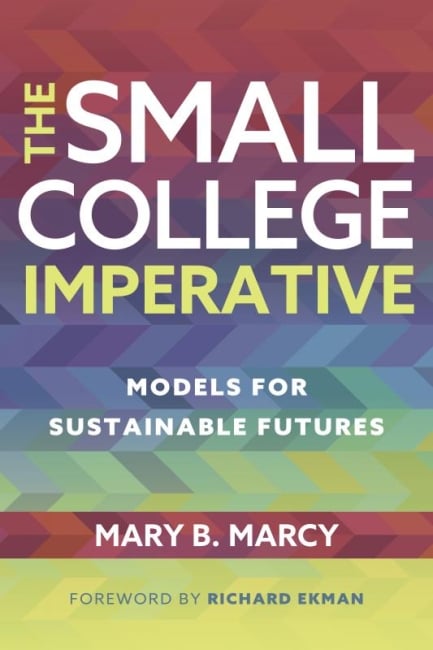You have /5 articles left.
Sign up for a free account or log in.

Courtesy of Stylus Publishing
Mary B. Marcy’s new book was published at a tough time.
Different formats of the book, The Small College Imperative (Stylus Publishing), launched in February and March of this year, just as the coronavirus pandemic seized attention across the country and U.S. higher education. But that doesn’t mean the book from Marcy, who is the president of Dominican University of California, should be ignored. It contains insight into the pressures bearing down on small colleges and deep discussion of models that might help them in the future.
Marcy answered questions by phone last week about the book and what’s changed since she wrote it. The following conversation has been edited for length and clarity.
Q: What prompted you to write this book?
A: It was actually a few years ago at our annual Board of Trustees retreat, and the board was asking me to talk about where Dominican sits in the larger higher education environment and how I was hoping to position us. I realized it would be helpful to not just say, “Oh, there are public colleges and private colleges.” It was more helpful to say, “This is the landscape and different ways to respond, and here is what we’re trying to do.”
Like any good academic, I started thinking really deeply about what independent and small colleges are doing to respond to external challenges, and so I initially presented this notion of five different models to the board. And out of that conversation, as can often happen in a good discussion, I realized there was actually a lot more to pursue.
Q: Would you change anything or add anything now that the pandemic has shaken so much of higher education?
A: I had the great timing of putting a book out right as the pandemic hit. It was perfect.
Q: A lot of people are spending more time reading, at least.
A: That’s true. Good point.
I will probably do some kind of new foreword or afterword this summer, when I have a little bit more time to reflect. But what I would say right now is I think the questions that it raises and some of the framework, I absolutely stand by.
What I would do is explore some of the areas in more depth. Specifically, I think the space for different kinds of partnerships and consortia is going to have more legs and more interest as we move forward. I asked a series of questions about not just what are places doing, but how do you do it. Given the pressure that the pandemic is bringing to bear on all institutions, I think I would probably spend a little more time on at least some of the ways other places have done it.
The third thing is, I think implied in the book is that some campuses are really reinforcing and almost doubling down on their residential nature. Others are really looking to use technology more and more, focused on outreach to other constituencies that may not be as in residence.
I think that probably can merit some more analysis as well in a pandemic-influenced world.
Q: We hear a lot about consortia, yet it’s one of those ideas that always seems to be undercovered or underdiscussed. Do you have any idea why it’s hard to talk about?
A: When I wrote the book, I was like, “This needs attention.” But it’s a chapter that almost didn’t make it in, because it is such a fast-moving space right now in independent higher ed. I almost didn’t put it in there because it felt like whatever I wrote would be having trouble catching up.
I’m happy to say that’s not true. I think what is there captures a rapidly shifting landscape. Having said that, there are a couple of reasons I think we’re not hearing a lot about it. One is there are a lot of things that are in their infancy. So in the book I talked about the lower-cost models for independent colleges consortium. That’s expanded now pretty significantly into a broader initiative.
So it’s moving quickly. It’s a really interesting space. It’s still a relatively new space, so it’s shifting quickly and then hard to hear about, because you can’t say, “This is exactly what’s happening now.”
I guess the other thing I would say is it is hard. Consortia and partnerships are hard, and you run into the most basic things that can get in the way of success. Everybody wants to partner in an online environment in one way or another. What’s the first question that’s asked? Well, usually, it’s, “What’s your course management system? And whose are we going to use, and how do we reconcile them?”
Our systems are built up for freestanding institutions. And so consortia, even though they also can be very attractive, challenge those systems.
Q: From our perspective as outsiders looking in, it can take more time to figure out what’s going on in consortia, because there are more moving parts than there are in a single institution.
A: And that’s one of the things that most small colleges don’t really have a lot of. Even though the attraction is there, with these kinds of partnerships, in some ways, the risk is greater, too. It’s not always the financial resources, but the time to build this. How much energy and how much institutional space do we have to put behind this?
Q: To bring us back to the pandemic, does it have you thinking about any different questions related to college finances?
A: I think higher education can’t be the great equalizer if it just serves a small portion of the population. And I think one of the most underappreciated aspects of a lot of independent higher ed is how many first-generation students, Pell-eligible students, underrepresented students have been successful in these institutions.
Whether that can continue to be the case with a high-tuition, high-aid model, I don’t know. The question you asked earlier, what I would change or what I would add, the space I really wanted to explore more deeply and I still would like to is the kind of alternative ways to finance higher education and independent higher education.
But the truth is, there aren’t a lot of other models out there for independent higher education. And some of them, like income-share agreements and so on, are really interesting, but they also have their own challenges, including right now in a recession where they’re dependent on up-front cash in order for investors to be paid later. Well, if people don’t have up-front cash, that’s a challenge.
I wish there was a nice straightforward answer to how you finance all of this.
But I do think the pandemic is going to push those issues of equity, access and financial models very intensely.
Q: Will key shifts you outline in the book -- college-age demographics, extreme stress on the business model, shifting market demands for different disciplines and a rapid evolution in educational technology -- remain important to watch?
A: Absolutely. It’s not so much what I would change. It’s where I would dive in deeper.
I think the questions are the right questions. The pace is going to be faster. The speed at which they hit and affect institutions is going to be much quicker.
Q: You also identified five models of innovation in higher education -- traditional, integrated, distinctive program, expansion and distributed. Do those hold as well?
A: I think they’re really useful frameworks. I would say something I talk about in the book and perhaps should have emphasized more is they’re not discrete. This is not an IKEA, put-it-together kind of kit.
They are frameworks for understanding ways to address the challenges that independent colleges face, and so a lot of folks I’ve talked to are saying, “We look a lot like a distinctive program, or we’re doing a little bit of expansion, too.”
I think that’s healthy. I’d also say they’re not all equal degrees of difficulty to adopt or equally valid for every institution. So the five models I almost think, as I get feedback from people and talk to colleagues, are almost like a bell curve, where traditional is a fantastic space if you can stay there, but it’s hard to stay there for everybody. And then the distributed model is really impressive to see, but there’s a reason there is only one institution used as an example of that model in the book. It’s an entirely different approach to education, really.
Those are kind of the bookends, and there is a lot of movement among the spaces in the center.
Q: What did we miss?
A: I wish I had talked a bit more about why it matters, why the institutions matter.
I think they matter if we care about educational equity. I think they matter if we care about the economic health of our communities.
They are often the mainstay for communities. I think it matters if we care about civic engagement and rebuilding our society now, because that’s what these institutions do.




